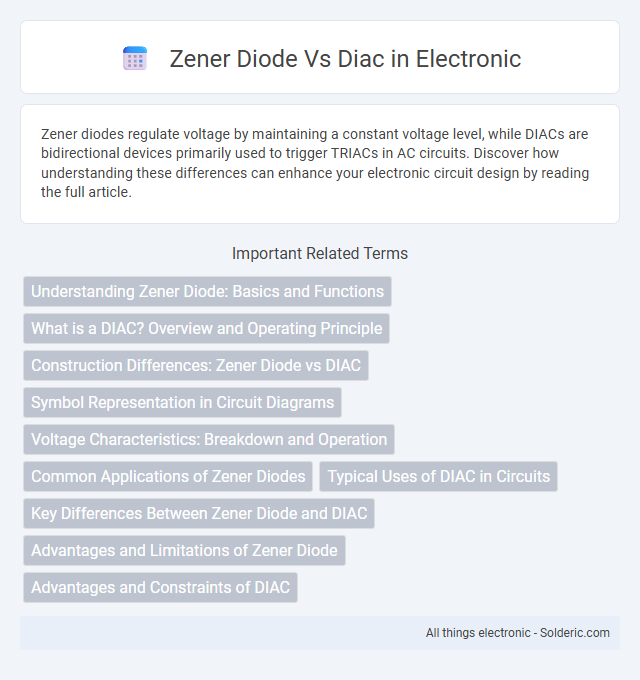Zener diodes regulate voltage by maintaining a constant voltage level, while DIACs are bidirectional devices primarily used to trigger TRIACs in AC circuits. Discover how understanding these differences can enhance your electronic circuit design by reading the full article.
Comparison Table
| Feature | Zener Diode | Diac |
|---|---|---|
| Function | Voltage regulation and voltage reference | Bidirectional trigger switch for AC circuits |
| Breakdown Voltage | Precisely controlled Zener voltage (typically 2.4V to 200V) | Typically 30V to 40V (non-controlled breakdown) |
| Polarity | Unidirectional | Bidirectional |
| Applications | Voltage stabilization, voltage clipping, reference elements | Trigger for TRIACs, AC switching circuits |
| Symbol | Diode with a bent line on cathode side | Two PN junctions connected in reverse parallel |
| Operating Principle | Conducts in reverse bias after Zener voltage is reached | Conducts after voltage exceeds threshold in either polarity |
Understanding Zener Diode: Basics and Functions
Zener diodes regulate voltage by allowing current to flow in reverse once a specific breakdown voltage is reached, ensuring stable voltage levels in circuits. Unlike Diacs, which trigger alternating current devices by switching at a breakover voltage without a fixed polarity, Zener diodes maintain precise voltage control under reverse bias conditions. Your electronic designs benefit from Zener diodes when needing reliable voltage reference and protection against voltage spikes.
What is a DIAC? Overview and Operating Principle
A DIAC is a bidirectional semiconductor device designed to conduct current only after its breakover voltage is reached, making it ideal for triggering TRIACs in AC circuits. It operates by remaining non-conductive until the voltage exceeds its threshold, then allowing current flow in both directions until the current drops below a holding level. Unlike a Zener diode, which regulates voltage by maintaining a constant breakdown voltage in a unidirectional manner, the DIAC functions primarily as a switch for AC signals without voltage regulation.
Construction Differences: Zener Diode vs DIAC
Zener diodes feature a heavily doped p-n junction designed to allow current to flow in the reverse direction when a specific breakdown voltage is reached, providing voltage regulation. DIACs consist of a symmetrical structure with two main terminals and no gate, constructed from a layered semiconductor material, enabling them to conduct current only after reaching a certain threshold voltage in either direction. Understanding these construction differences helps you select the appropriate device for voltage regulation or triggering applications.
Symbol Representation in Circuit Diagrams
The Zener diode symbol in circuit diagrams is represented by a diode symbol with bent edges on the cathode line, indicating its voltage regulation property. In contrast, the DIAC symbol resembles a bidirectional diode with two terminals and no polarity, showing its ability to conduct current in both directions after a breakover voltage is reached. These distinct symbols help differentiate their functions in circuits, with Zener diodes used for voltage stabilization and DIACs for triggering applications.
Voltage Characteristics: Breakdown and Operation
Zener diodes exhibit precise voltage regulation by maintaining a stable breakdown voltage typically ranging from a few volts to several hundred volts, enabling controlled reverse conduction without damage. Diacs, on the other hand, have a higher and less defined breakdown voltage generally between 20V to 40V and operate by triggering conduction symmetrically in both directions once this voltage threshold is reached. Zener diodes operate primarily in reverse bias for voltage clamping, whereas Diacs function as bidirectional triggering devices used in AC switching applications.
Common Applications of Zener Diodes
Zener diodes are widely used for voltage regulation in power supplies, providing a stable reference voltage to protect sensitive electronic components. They are essential in voltage clamping circuits, ensuring that voltage spikes do not exceed specified levels. Zener diodes also serve in waveform clipping applications to maintain signal integrity in communication systems.
Typical Uses of DIAC in Circuits
DIACs are typically used in triggering applications within AC circuits, such as phase control in light dimmers, motor speed regulators, and heater controls, where precise switching is essential. Unlike Zener diodes that provide voltage regulation by clamping voltage at a specific level, DIACs function as bidirectional switches that conduct current only after their breakover voltage is reached. Your circuits benefit from DIACs when controlling AC power without the need for complex triggering methods.
Key Differences Between Zener Diode and DIAC
Zener diodes regulate voltage by maintaining a constant reverse breakdown voltage, typically used for voltage regulation and reference in electronic circuits. DIACs are bidirectional trigger devices that conduct current only after reaching a specific breakdown voltage, primarily used in triggering triacs for AC switching applications. Unlike Zener diodes, DIACs do not maintain a voltage but act as switches, making their applications and functions distinct.
Advantages and Limitations of Zener Diode
Zener diodes offer precise voltage regulation and reliable performance in low-voltage applications, making them ideal for voltage reference and protection circuits. Their main limitations include lower power handling capacity and slower response time compared to dynamic switching components. Unlike Diacs, Zener diodes operate with a defined breakdown voltage, providing stable clamping but lack bidirectional triggering required for AC switching functions.
Advantages and Constraints of DIAC
DIACs offer the advantage of symmetrical switching, which enables precise triggering in AC circuits and improved control in phase angle applications. Their constraints include limited voltage and current ratings compared to other semiconductor devices, reducing their suitability for high-power applications. DIACs lack the voltage regulation feature inherent in Zener diodes, restricting their use in voltage stabilization contexts.
Zener diode vs Diac Infographic

 solderic.com
solderic.com